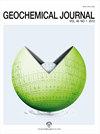石曼托增生杂岩锆石U-Pb年龄和Hf同位素组成:非均质来源的证据
IF 1.6
4区 地球科学
Q3 GEOCHEMISTRY & GEOPHYSICS
引用次数: 1
摘要
日本地球化学学会版权所有©2020。后一种方法已被证明是识别沉积物来源(或有时仅改变源区)和源区地质组成和演化的有力工具(例如,Aoki等人,2014;Bodet and Schärer, 2000;邓等人,2017;Hara et al., 2017;Lan et al., 2016)。一个被充分研究的增生杂岩是沿日本西南和中部沿活动大陆边缘沿太平洋一侧分布的岛满托带。由于沿中构造线的运动,该带可能相对于源区发生了位移(例如,Ikeda et al., 2016;Sakashima et al., 2003)。许多研究已经处理了这个带的各个方面。年龄限制主要通过放射虫生物地层学研究获得(例如,Suzuki和Fukuda, 2012;Hara and Hara, 1919a, b).最近,碎屑锆石的定年已被用于改进这些年龄分配(例如,Hara and Hara, 2019b;Hara et al., 2017;Shibata et al., 2008;Tokiwa et al., 2016, 2017)。Hara et al.(2017)也使用U-Pb锆石谱来讨论构成四国南部岛满托带的沉积物的来源。石曼托增生杂岩锆石U-Pb年龄和Hf同位素组成:非均质来源的证据本文章由计算机程序翻译,如有差异,请以英文原文为准。
U-Pb ages and Hf isotope composition of zircon from the Shimanto accretionary complex: Evidence for heterogeneous sources
Copyright © 2020 by The Geochemical Society of Japan. The latter methods have proven to be powerful tools to identify the sources of the sediments (or sometimes only changing source areas) and the geologic make-up and evolution of source areas (e.g., Aoki et al., 2014; Bodet and Schärer, 2000; Deng et al., 2017; Hara et al., 2017; Lan et al., 2016). A well studied accretionary complex is the Shimanto Belt distributed along the Pacific side of south-west and central Japan along an active continental margin. This belt may have been displaced relative to the source area due to movements along the Median Tectonic Line (e.g., Ikeda et al., 2016; Sakashima et al., 2003). Numerous studies have dealt with various aspects of this belt. Age constraints were largely obtained by studies of the radiolarian biostratigraphy (e.g., Suzuki and Fukuda, 2012; Hara and Hara, 1919a, b). Recently, the dating of detrital zircon has been used to refine these age assignments (e.g., Hara and Hara, 2019b; Hara et al., 2017; Shibata et al., 2008; Tokiwa et al., 2016, 2017). Hara et al. (2017) also used the spectra of U-Pb zircon ages to discuss the provenance of the sediments that constitute the Shimanto belt in southern Shikoku. U-Pb ages and Hf isotope composition of zircon from the Shimanto accretionary complex: Evidence for heterogeneous sources
求助全文
通过发布文献求助,成功后即可免费获取论文全文。
去求助
来源期刊

Geochemical Journal
地学-地球化学与地球物理
CiteScore
1.70
自引率
12.50%
发文量
11
审稿时长
6 months
期刊介绍:
Geochemical Journal is an international journal devoted to original research papers in geochemistry and cosmochemistry. It is the primary journal of the Geochemical Society of Japan. Areas of research are as follows:
Cosmochemistry; Mineral and Rock Chemistry; Volcanology and Hydrothermal Chemistry; Isotope Geochemistry and Geochronology; Atmospheric Chemistry; Hydro- and Marine Chemistry; Organic Geochemistry; Environmental Chemistry.
 求助内容:
求助内容: 应助结果提醒方式:
应助结果提醒方式:


